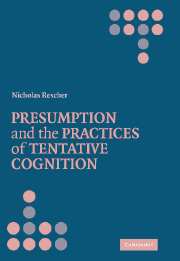Book contents
- Frontmatter
- Contents
- Preface
- Presumption and the Practices of Tentative Cognition
- 1 The Legal Roots Of Presumption
- 2 Presumption and Burden of Proof
- 3 Cognitive Presumption and Truth
- 4 Validating Cognitive Presumptions
- 5 Presumption and Inquiry
- 6 Default Reasoning
- 7 Presumption and Trust
- 8 Presumption and Communication
- 9 Presumption in Science and Beyond
- 10 Specificity Prioritization and the Primacy of the Particular
- 11 Dismissing Extremely Remote Possibilities
- Conclusion
- Bibliography
- Index of Names
2 - Presumption and Burden of Proof
Published online by Cambridge University Press: 24 July 2009
- Frontmatter
- Contents
- Preface
- Presumption and the Practices of Tentative Cognition
- 1 The Legal Roots Of Presumption
- 2 Presumption and Burden of Proof
- 3 Cognitive Presumption and Truth
- 4 Validating Cognitive Presumptions
- 5 Presumption and Inquiry
- 6 Default Reasoning
- 7 Presumption and Trust
- 8 Presumption and Communication
- 9 Presumption in Science and Beyond
- 10 Specificity Prioritization and the Primacy of the Particular
- 11 Dismissing Extremely Remote Possibilities
- Conclusion
- Bibliography
- Index of Names
Summary
Introduction
Presumption is closely bound to the idea of burden of proof (onus probandi), which is also at root a legal conception. It functions in the context of an adversarial proceeding in which one party is endeavoring to establish and another to rebut some charge before a neutral adjudicative tribunal. The very phrase (onus probandi) derives from classical Roman law where it affords one of the ground rules of probative procedure, governing the division of the labor of argumentation between plaintiff and defendant, which specifies tasks of marshaling evidence. Under the Roman system, nothing was conceded in legal actions as admitted: the plaintiff, as the initiating agent in laying a charge, had to make his case first (agenti incumbit probatio), then the defendant's countercase was argued on his exceptio, and thereafter the plaintiff's on his replication, and so on. The burden rested with the plaintiff in civil cases and with the state (as surrogate plaintiff) in criminal cases. Throughout, the “burden of proof” lay with the side active in making the allegations, subject to the fundamental rule that “the need for proof lies with him who affirms, not him who denies.”
The idea of burden of proof embodies a basic ground rule of the probative process. To say that the burden of proof rests with a certain side is to say that side must adduce the substantiation required to make its case.
Information
- Type
- Chapter
- Information
- Presumption and the Practices of Tentative Cognition , pp. 13 - 26Publisher: Cambridge University PressPrint publication year: 2006
